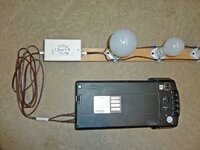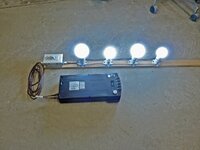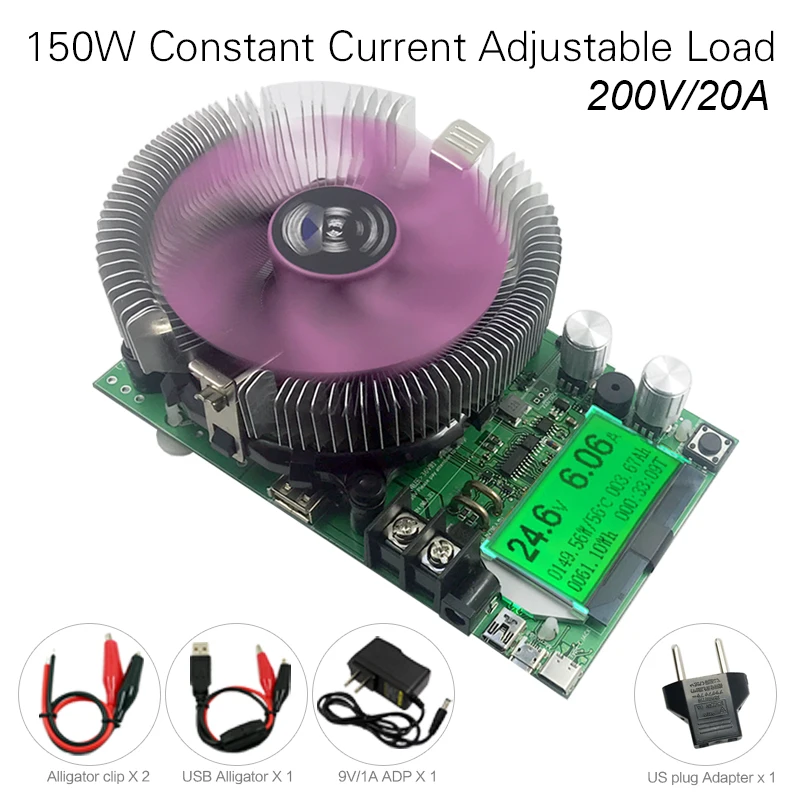You are using an out of date browser. It may not display this or other websites correctly.
You should upgrade or use an alternative browser.
You should upgrade or use an alternative browser.
How can I partially discharge Bosch battery?
- Thread starter rbeckert
- Start date
6zfshdb
Well-Known Member
- Region
- USA
- City
- Northeast Pennsylvania
Put it on a work stand or hang it from the ceiling with rope. Then run the motor to discharge.
If the bike has a headlight, you can also park the bike with the light on. It could take a couple of days though.
If you're handy with tools, you can also make a discharge rig using these low voltage LED bulbs:
You'll also need to make a plug to connect to the battery.
This is one I made for my 52V batteries. I added a timer to adjust the length of the discharge cycle.

If the bike has a headlight, you can also park the bike with the light on. It could take a couple of days though.
If you're handy with tools, you can also make a discharge rig using these low voltage LED bulbs:
You'll also need to make a plug to connect to the battery.
This is one I made for my 52V batteries. I added a timer to adjust the length of the discharge cycle.
William - Bosch Team
Well-Known Member
If your local IBD has a Bosch BCT (Battery Capacity Tester), they can use the discharge function on the BCT to safely discharge your battery. It will take them a few hours.
fooferdoggie
Well-Known Member
that wont work with a mid drive without a throttle. the headlight and computer will turn off after a few minutes of inactivityPut it on a work stand or hang it from the ceiling with rope. Then run the motor to discharge.
If the bike has a headlight, you can also park the bike with the light on. It could take a couple of days though.
Why would you want low voltage LED bulbs? You want load, not efficiency. I'd use incandescent bulbs, if anything. Heck, you could connect standard 110v incandescent if you can find any, or use a halogen bulb. Doesn't matter if you use it at less than rated voltage. FYI, a 100 watt 110v incandescent bulb would have about 100 ohms resistance, so would draw about 1/2 amp on a 50 volt battery, so you might want a bigger bulb depending on your battery capacity and patience.Put it on a work stand or hang it from the ceiling with rope. Then run the motor to discharge.
If the bike has a headlight, you can also park the bike with the light on. It could take a couple of days though.
If you're handy with tools, you can also make a discharge rig using these low voltage LED bulbs:
You'll also need to make a plug to connect to the battery.
This is one I made for my 52V batteries. I added a timer to adjust the length of the discharge cycle.
I doubt if one would be able to safely wire up a Bosch battery though, not knowing the pinout of the connector. Use the wrong ones, and you risk damaging the battery, or worse.
Sparky731
Well-Known Member
- Region
- USA
I have the same problem on my wife’s bike. I have been turning on the headlight as often as I remember. It turns off after ~10 min, but any discharge is better than none. (FYI, I also have a 7s. Kudos to you on your ride.)I have to store a TREK Allant+ 7S with a Bosch PowerTube 500 battery. It is currently charged to 100% and I would like to discharge it to 30%-60% for storage. I cannot ride it to drain the battery.
tomjasz
Well-Known Member
- Region
- USA
- City
- Minnesnowta
It’s not LiPo.Does you bike have a USB port? hooking up a light or something similar would drain power for you. Personally I would the never store a Lipo celled battery @ 30%, IMO even 60% is pushing it. I shoot for about 70-80% charge for long term storage.
6zfshdb
Well-Known Member
- Region
- USA
- City
- Northeast Pennsylvania
The discharge rig serves a dual purpose. I use it as an outdoor portable light source and inside as well during power outages. When fully charged, the battery will provide a lot of light for around 15 hours. I don't care if it takes 5 or 6 hours to discharge for storage. That's what the timer is for.Why would you want low voltage LED bulbs? You want load, not efficiency.
rich c
Well-Known Member
Bosch would shut down and the light goes off in something like 4 minutes when just sitting unused.Put it on a work stand or hang it from the ceiling with rope. Then run the motor to discharge.
If the bike has a headlight, you can also park the bike with the light on. It could take a couple of days though.
If you're handy with tools, you can also make a discharge rig using these low voltage LED bulbs:
You'll also need to make a plug to connect to the battery.
This is one I made for my 52V batteries. I added a timer to adjust the length of the discharge cycle.
View attachment 101426
If you're handy with tools, you can also make a discharge rig using these low voltage LED bulbs:
You'll also need to make a plug to connect to the battery.
This is one I made for my 52V batteries. I added a timer to adjust the length of the discharge cycle.

Solution for a second battery
Hello guys. I would like to mount a second battery on my e-bike, and I have been looking for a kit to mount the second battery, but i didn't find one. Do you have any suggestions for one? My e-bike is powered by bosch 3th generation, powerpack battery. I would like to mount something like in...
rbeckert
Member
- Region
- USA
Sadly, no USB port. The Bosch manual says 30%-60% charge for storage.Does you bike have a USB port? hooking up a light or something similar would drain power for you. Personally I would the never store a Lipo celled battery @ 30%, IMO even 60% is pushing it. I shoot for about 70-80% charge for long term storage.
rbeckert
Member
- Region
- USA
Put it on a work stand or hang it from the ceiling with rope. Then run the motor to discharge.
If the bike has a headlight, you can also park the bike with the light on. It could take a couple of days though.
If you're handy with tools, you can also make a discharge rig using these low voltage LED bulbs:
You'll also need to make a plug to connect to the battery.
This is one I made for my 52V batteries. I added a timer to adjust the length of the discharge cycle.
View attachment 101426
Thanks for the suggestion!If your local IBD has a Bosch BCT (Battery Capacity Tester), they can use the discharge function on the BCT to safely discharge your battery. It will take them a few hours.
PedalUma
Well-Known Member
- Region
- USA
- City
- Petaluma, CA
Looks like the way to go. Too bad about not having a USB port on the bike. I just run a USB fan from these. The easy option would be to go for a ride.Thanks for the suggestion!
Alex Baybak
New Member
- Region
- Europe
Hi everybody. I own two e-bikes. One is equipped with bosch powertube 500wh, and another one with bosch powerpack 500wh. I’m trying to find a way how to manually discharge the batteries removed from bike or alternatively installed on it. For this purpose I have soldered in series three car 12V 22W bulbs as a discharge load. As for now, I know that:
1. BMS locks power supply to battery terminals when battery is disconnected, hence you are not able to check voltage or connect any load to it.
2. One way to get a voltage on the battery terminals is to supply +5VDC to Grey terminal ref to the picture and negative to Battery minus terminal. By this way we are simulating BMS to think that charger is connected. And we can get voltage readings at battery +/- terminals. But once I connect my handmade 36V load, then in 2 seconds voltage is tripped, I guess by BMS as a kind of protection. It is supposed to be charging but it is discharging, so the protection is being activated and it is not possible to discharge the battery in such a way.
3. Another way – battery is installed on bike. Power ON. Battery voltage readings available at charging port @ +/- at main battery terminals. I connect my handmade load, the bulbs are lightning up and the battery starts discharging, but approx. in 10 minutes the power turns off due to inactivity and my discharging bulbs are switched off as well. This way is not suitable because you need to reset power every 10 or so minutes. Are there any options how to extend this sleep timer? I was trying to activate a walking mode and to hold “i” button by a cable tie, but seems like it is not a way to bypass a sleeping timer as the bike is inactive/not moving.
 4. One more observation – battery is on the bike. I have measured the voltage on the remaining terminals – green and yellow on my pic and found 2.48 vdc on each. Afterwards I have removed battery from bike and tried to supply the same 2.48vdc to each of the terminals. When I give 2.48 vdc to green terminal – nothing is happening, once I supply 2.48vdc to yellow terminal – battery charge level indicator starts flickering, but I still don’t get a voltage on the main battery terminals. Seems like this terminals for communication purpose between bike’s units, but I’m not sure. If is it possible to wake up battery somehow using this terminals?
4. One more observation – battery is on the bike. I have measured the voltage on the remaining terminals – green and yellow on my pic and found 2.48 vdc on each. Afterwards I have removed battery from bike and tried to supply the same 2.48vdc to each of the terminals. When I give 2.48 vdc to green terminal – nothing is happening, once I supply 2.48vdc to yellow terminal – battery charge level indicator starts flickering, but I still don’t get a voltage on the main battery terminals. Seems like this terminals for communication purpose between bike’s units, but I’m not sure. If is it possible to wake up battery somehow using this terminals?
5. One more option is to get a Bosch BCT 100 Battery Capacity Tester. However, it is not available in my country and the price is 400-500euro as I could see it at online stores.
6. Also it is possible to mount an external connector and run the cables directly to battery plus and minus and to discharge battery bypassing the BMS. But this method requires opening the battery casing and making some hole for the cable, which I don’t like to do…
As for now I’m stuck and don’t have any ideas how to make battery manually discharge. Seeking for yours help.
Thanks for reading. Cheers.
1. BMS locks power supply to battery terminals when battery is disconnected, hence you are not able to check voltage or connect any load to it.
2. One way to get a voltage on the battery terminals is to supply +5VDC to Grey terminal ref to the picture and negative to Battery minus terminal. By this way we are simulating BMS to think that charger is connected. And we can get voltage readings at battery +/- terminals. But once I connect my handmade 36V load, then in 2 seconds voltage is tripped, I guess by BMS as a kind of protection. It is supposed to be charging but it is discharging, so the protection is being activated and it is not possible to discharge the battery in such a way.
3. Another way – battery is installed on bike. Power ON. Battery voltage readings available at charging port @ +/- at main battery terminals. I connect my handmade load, the bulbs are lightning up and the battery starts discharging, but approx. in 10 minutes the power turns off due to inactivity and my discharging bulbs are switched off as well. This way is not suitable because you need to reset power every 10 or so minutes. Are there any options how to extend this sleep timer? I was trying to activate a walking mode and to hold “i” button by a cable tie, but seems like it is not a way to bypass a sleeping timer as the bike is inactive/not moving.
5. One more option is to get a Bosch BCT 100 Battery Capacity Tester. However, it is not available in my country and the price is 400-500euro as I could see it at online stores.
6. Also it is possible to mount an external connector and run the cables directly to battery plus and minus and to discharge battery bypassing the BMS. But this method requires opening the battery casing and making some hole for the cable, which I don’t like to do…
As for now I’m stuck and don’t have any ideas how to make battery manually discharge. Seeking for yours help.
Thanks for reading. Cheers.
Maybe the BMS doesn't like such a low resistance (3 x bulbs) and determines it's in a short circuit state.For this purpose I have soldered in series three car 12V 22W bulbs as a discharge load. As for now, I know that:
When it's on the bike there would be more resistance - motor electronics, longer cables, etc. Maybe with your load in parallel it may be enough.
Or there's a particular sequence/timing to the 5VDC on the CAN Bus line.
Some of the other conductors are used for 6A charging i think.
Alex Baybak
New Member
- Region
- Europe
Perfect, thanks for advise.Maybe the BMS doesn't like such a low resistance (3 x bulbs) and determines it's in a short circuit state.
When it's on the bike there would be more resistance - motor electronics, longer cables, etc. Maybe with your load in parallel it may be enough.
I have connected directly 220V 100W bulb to battery terminals and supplied +5vdc to "charger" terminal and BMS is not tripping anymore.
But I need to increase load as my 1 bulb 220V 100W takes ~0.18A only (measured by multimeter) and it will take forever to discharge the battery.
Resistance of bulb + wires ~36Ohms + battery resistance ~98Ohms gives 134Ohms
I=U/R; I=36v/134Ohm=0.26A which is close to multimeter readings.
Thanks again for yours advice.
6zfshdb
Well-Known Member
- Region
- USA
- City
- Northeast Pennsylvania
Why not use several bulbs in parallel and add a timer? It may take several hours to get the voltage down to storage level. Is there a reason you need to discharge the battery quickly?
I don't have Bosch equipment but I discharge my 52V batteries with a rig made from six of these low voltage 15 watt LED bulbs wired in parallel:
E26 socket base:
And this timer:


With 6 bulbs, the total draw is 2A which sometimes takes a few hours to get the charge level I want. More bulbs could be added if necessary but I have no need for a faster discharge rate. Simple math tells me how long to activate the timer so I can set and forget it. I have the bulbs mounted on a wood strip which hangs on a wall for use as a portable light source during our frequent power outages.
For convenience, I added this voltmeter to easily check the charge level:
I don't have Bosch equipment but I discharge my 52V batteries with a rig made from six of these low voltage 15 watt LED bulbs wired in parallel:
E26 socket base:
And this timer:


With 6 bulbs, the total draw is 2A which sometimes takes a few hours to get the charge level I want. More bulbs could be added if necessary but I have no need for a faster discharge rate. Simple math tells me how long to activate the timer so I can set and forget it. I have the bulbs mounted on a wood strip which hangs on a wall for use as a portable light source during our frequent power outages.
For convenience, I added this voltmeter to easily check the charge level:
Or if time & money isn't an issue:

 www.aliexpress.com
www.aliexpress.com

40.73US $ |200v 150w Adjustable Constant Current Electronic Load Battery Usb Tester Dc 12v 24v Lead-acid Lithium Discharge Capacity Meter - Battery Testers - AliExpress
Smarter Shopping, Better Living! Aliexpress.com
We were fortunate that we knew last fall when our last ride would be, so we didn't charge after it. Saying that, I wonder how many folks actually worry about charge level for seasonal storage? I also wonder if the risk of damage in rigging up a discharge solution is exceeds the (theoretical) gain from partial discharge before storage?
Similar threads
- Replies
- 2
- Views
- 499
- Replies
- 7
- Views
- 761
- Replies
- 2
- Views
- 684

